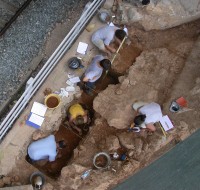 Excavations at Riparo Bombrini, a collapsed rock shelter in the Balzi Rossi Paleolithic site complex in Liguria, near the Italian-French border, have revealed that the Neanderthals who lived there for thousands of years in the late Middle Paleolithic organized their living spaces much like modern humans. (The full paper published in the Canadian Journal of Archaeology can be read gratis here.) Many researchers have identified clearly structured and patterned uses of space as a marker of modern human behavior, but some recent discoveries of Neanderthal dwellings have cast doubt on that classification. The Riparo Bombrini finds provide extensive evidence that the Neanderthals of the Late Mousterian era (the oldest there date to around 45,000 years ago) compartmentalized the space by usage.
Excavations at Riparo Bombrini, a collapsed rock shelter in the Balzi Rossi Paleolithic site complex in Liguria, near the Italian-French border, have revealed that the Neanderthals who lived there for thousands of years in the late Middle Paleolithic organized their living spaces much like modern humans. (The full paper published in the Canadian Journal of Archaeology can be read gratis here.) Many researchers have identified clearly structured and patterned uses of space as a marker of modern human behavior, but some recent discoveries of Neanderthal dwellings have cast doubt on that classification. The Riparo Bombrini finds provide extensive evidence that the Neanderthals of the Late Mousterian era (the oldest there date to around 45,000 years ago) compartmentalized the space by usage.
There are three main groupings of Mousterian occupation levels in the rock shelter. These are palimpsests, to be clear, composites of varied dates within a range, not individually dated occupation levels. The top level (labeled Level MS) appears to have been a task site likely dedicated to the slaughter, butchering and perhaps skin processing of game. Researchers found a dense concentration of animal bones in the top level towards the back of the shelter, the densest anywhere on the site. They also found abundant evidence of ochre in the same area. They don’t know what it was used for, but it has several work applications — tanning, gluing — or it could have had some ritual purpose.
The middle group (Levels M1-M5) was a long-term logistical base camp, as evidenced by a high density of animal bones, shells from edible shellfish and stone tools in the front of shelter’s mouth and a hearth at the back bounded by a clear area. The occupants appear to have done all the work that might result in irritating or dangerous debris at the mouth of the shelter and kept the back of the shelter, where people slept and socialized around the fire, clean.
Researchers believe the bottom group (Levels M6-M7) served as a short-term base camp. Unlike the other levels, here the remains of fauna are sparse while lithic debris (fragments of stone chipped away in the making and use of tools) is relatively dense. There is more stone debris just inside the shelter than outside in these levels, an indication that the area was used for temporary work stints, like for making tools, in the opening of the shelter where sunlight would have been most plentiful. It could also have been used as a dump site of sorts, to contain potentially dangerous discards like sharp flint fragments.
“This is ongoing work, but the big picture in this study is that we have one more example that Neanderthals used some kind of logic for organizing their living sites,” [University of Colorado Denver anthropologist Julien] Riel-Salvatore said. “This is still more evidence that they were more sophisticated than many have given them credit for. If we are going to identify modern human behavior on the basis of organized spatial patterns, then you have to extend it to Neanderthals as well.”
Interestingly, Riel-Salvatore’s team published a study in 2011 that found no differentiation in the spatial patterning of artifacts in the Mousterian levels of Riparo Bombrini. This time around they analyzed the data considering mobility strategies of the hominids using the space and the size of the excavated areas and the piles of shells, bones and stones revealed themselves to have clear patterns. It’s important for the study of other Neanderthal sites going forward because it gives researchers an approach that might expose spatial patterning that went unnoticed in earlier explorations.
Riparo Bombrini also has the advantage of having been used by a later hominid group from the Aurignac culture (45,000 to 35,000 years ago), the early modern humans who made some of the earliest known examples of figurative art (like Lion Man and the Chauvet cave paintings). The research team plans to examine the Aurignacian levels for spatial patterning as well, which will allow them to compare Neanderthal and homo sapiens usage of the same space, thereby ruling out differences in site form and structure as a reason for any differences between the two.